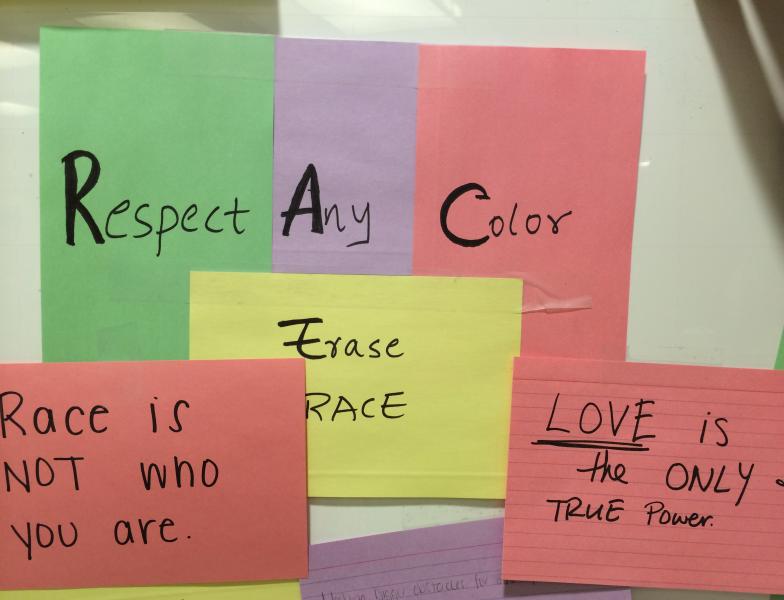Education
Monday, February 10, 2014
University of Akron hosts Race Card project, ethnicity bending video game
It's part of the annual "Rethinking Race" series
by WKSU's KABIR BHATIA |

Reporter
Kabir Bhatia | | |
 | | Meghan Carroll was amazed at her Hispanic look, amused at herself as Asian, annoyed at herself as Indian and surprised at the one that should have been unsurprising: white. It's all possible with the "In Your Face" video machine in the student union | | Courtesy of KABIR BHATIA |
Dozens of colorful index cards, and a race-morphing video game, are among the highlights of the University of Akron's “Rethinking Race” week. WKSU's Kabir Bhatia reports on the activities designed to start a dialogue about diversity. |
University of Akron hosts Race Card project, ethnicity bending video gameOther options:  MP3 Download (3:33) MP3 Download (3:33)
|
The University of Akron was chosen in 1997 by President Bill Clinton as the site of the first Town Hall meeting on race. Every February since then, the university has hosted speakers and forums that examine issues of diversity, aimed at engaging both students and the public at large. then, the university has hosted speakers and forums that examine issues of diversity, aimed at engaging both students and the public at large.
The Race Card Project
Colorful index cards -- about 100 as of this weekend, but growing daily -- are displayed on a garage-door-sized whiteboard in the lobby of Bierce Library, on the north side of campus. The project springs from the brainchild of Michele Norris, an NPR host, special correspondent and head of “The Race Card Project.” She spoke in Akron Monday and talked about the project with Genconnect.com.
“I collect people's stories about race and identity in six words: their thoughts, their anthems, their hopes, their lament, their worry about race, in little six-word spurts. And that six words is often the beginning of a much larger conversation.”
At Akron, the cards have messages ranging from “There is only one race: Human,” to “Respect any color: erase race” to more fervent calls for acceptance of specific groups.
 Carried Away Carried Away
Will Carter is a junior phys. ed major, and says the messages can sometimes use racism to attack racism.
"Some people might get carried away. For example, we had someone say something about, 'Not all black guys eat watermelon.' We had someone use the N-word to describe themselves. So we had to take that down.
"But for the most part, most of the stuff is positive stuff. It's a good thing to do to get people to express their feelings about race issues. We might have different values and cultures, but for the most part, we're just all people."
In Your Face
Nearby, in the student union, is a more technological exercise on race. The “In Your Face” machine looks like a videogame console for a racing or aviation game -- the kind that combines a screen, game controls and a seat into a pod-like structure.
Meghan Carroll, a sophomore English major, took the plunge. She's three-quarters Irish, and looks it: ginger hair, bright blue eyes and porcelain skin. With a half-dozen friends watching, the machine took her picture and then let her see herself as Asian. Her friends laughed heartily, but were oohing and aahing at Hispanic Meghan, adding, "You're pretty.” half-dozen friends watching, the machine took her picture and then let her see herself as Asian. Her friends laughed heartily, but were oohing and aahing at Hispanic Meghan, adding, "You're pretty.”
But the biggest surprise was when she clicked the button to see herself as white. One friend said she looked like her own sister, before Meghan proclaimed, “It looks like they put makeup on me.”
Carroll says the only one she didn’t like was the choice for Indian because it "made me look kind of fat.” For her, it's not about race, but about looking good. “It's just interesting to see how you COULD look different.”
Her friend, Mike McGowan, agrees, saying the machine shows that physical differences are immaterial. “Honestly, it doesn't really matter how you look. It doesn't change the person who you are. It's more about where you're raised.”
 That, to him, is the point of this week's Rethinking Race forums: finding commonality in your background while ignoring appearances. That, to him, is the point of this week's Rethinking Race forums: finding commonality in your background while ignoring appearances.
Along with the "In Your Face” race machine, and the Race Card Project, Akron is hosting keynote speakers throughout the week. Tonight, Ernest Green will be at E.J. Thomas Hall. He was one of the "Little Rock Nine" who integrated Central High School in Arkansas in 1955, one of the key victories in the 20th century Civil Rights movement. |
|